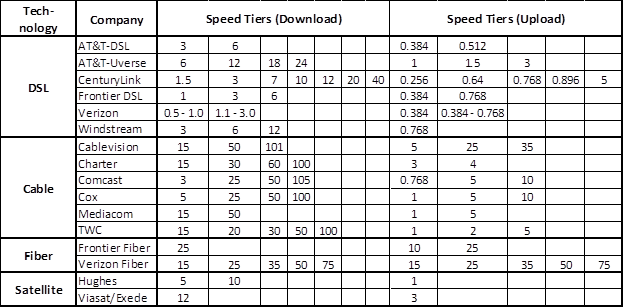FCC releases fifth 'measuring broadband America' report - FierceTelecom
Nationwide test of fixed broadband services shows significant increase in broadband speeds offered to consumers
WASHINGTON, December 30, 2015 – The Federal Communications Commission today released the results of its ongoing nationwide performance study of consumers' fixed broadband Internet access service in its fifth "Measuring Broadband America" report. The report furthers the Commission's efforts to provide greater transparency about network performance to help consumers make more informed choices about broadband services. This year's report shows that broadband speed offerings to the average consumer continue to increase at a rapid pace, and broadband service providers generally are delivering actual speeds that meet or exceed advertised speeds. However, results are not uniform across technologies. The report finds a growing disparity in advertised download speeds between many DSL-based broadband services and most cable- and fiber-based broadband services.
This year's report highlights the following findings:
- Significant growth in advertised broadband speeds available to consumers, though the results are not uniform across technologies. Averaged across all participating ISPs, maximum advertised speeds increased from 37.2 Mbps in September 2013 to 72 Mbps in September 2014 – an increase of 94 percent.
- Largely spurred by the deployment of enabling technologies such as DOCSIS 3, the maximum advertised download speeds offered by ISPs using cable systems increased from 12-20 Mbps in March 2011 to 50-105 Mbps in September 2014.
- However, popular maximum DSL speed offerings have not kept up with that growth. While average DSL consumer speeds have increased, popular maximum DSL speed offerings have stayed largely stagnant since 2011, with most DSL providers offering maximum download rates of 12 Mbps or less.
- Actual speeds experienced by most ISPs' subscribers are close to or exceed advertised speeds.
- All ISPs using cable, fiber or satellite technologies advertise speeds for services that on average are close to or below the actual speeds experienced by their subscribers.
- However, some DSL providers continue to advertise speeds that on average exceed actual speeds.
- Consumers with access to faster services continue to migrate to higher service tiers.
- Participating panelists who in September 2013 subscribed to service tiers with advertised speeds between 15 and 30 Mbps – offered mostly by cable and fiber services – migrated at high rates within the following year to a service tier with a higher advertised download speed.
- In contrast, among panelists subscribed in September 2013 to service tiers with advertised download speeds of less than 15 Mbps – offered mostly by DSL services – only a few percent migrated within the following year to a service tier with a higher download speed.
- Latency and packet loss vary by technologies.
- Consumers generally experienced low latency – the time it takes for a data packet to travel from one point to another in a network – on DSL, cable and fiber systems.
- Higher latency in satellite services may affect the perceived quality of highly interactive applications such as VoIP calls, video chat and multiplayer games.
- Consumers generally experienced low packet loss – the percentage of packets that are sent by the source but not received by the destination – on cable, satellite and fiber systems.
- Moderate packet loss experienced by a few DSL providers may affect the perceived quality of video chat, multiplayer games and video streaming.
FCC Broadband Report Ranks HughesNet® Gen4 Internet Service Highest in Meeting Advertised... -- GERMANTOWN, Md., Jan. 6, 2016 /PRNewswire/ --
GERMANTOWN, Md., Jan. 6, 2016 /PRNewswire/ -- HughesNet® Gen4 satellite broadband service ranked first among all major Internet service providers for delivering on advertised performance promises in the Federal Communications Commission's (FCC) fifth annual report on consumer broadband services, "Measuring Broadband America – 2015," issued on December 30, 2015.
HughesNet is America's #1 satellite broadband service with more than 1 million subscribers, and is delivered by Hughes Network Systems, LLC (Hughes), the world's leading provider of broadband satellite solutions and services.



No comments:
Post a Comment